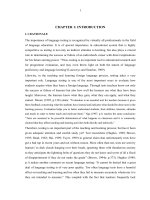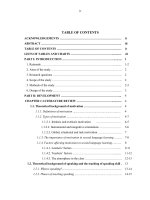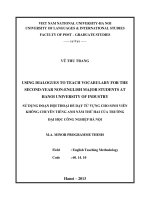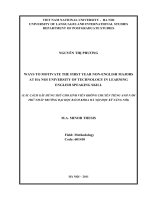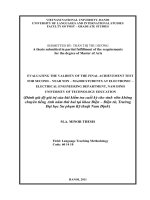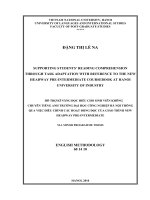Các cách gây hứng thú cho sinh viên không chuyên Tiếng Anh năm thứ nhất trường Đại Học Bách khoa Hà Nội học kỹ năng nói tt.PDF
Bạn đang xem bản rút gọn của tài liệu. Xem và tải ngay bản đầy đủ của tài liệu tại đây (673.83 KB, 16 trang )
VIET NAM NATIONAL UNIVERSITY - HA NOI
UNIVERSITY OF LANGUAGES AND INTERNATIONAL STUDIES
DEPARTMENT OF POSTGRADUATE STUDIES
NGUYỄN THỊ PHƯƠNG
WAYS TO MOTIVATE THE FIRST YEAR NON-ENGLISH MAJORS
AT HA NOI UNIVERSITY OF TECHNOLOGY IN LEARNING
ENGLISH SPEAKING SKILL
(CÁC CÁCH GÂY HỨNG THÚ CHO SINH VIÊN KHÔNG CHUYÊN TIẾNG ANH NĂM
THỨ NHẤT TRƯỜNG ĐẠI HỌC BÁCH KHOA HÀ NỘI HỌC KỸ NĂNG NÓI)
M.A. MINOR THESIS
Field: Methodology
Code: 601410
HÀ NỘI – 2011
VIET NAM NATIONAL UNIVERSITY - HA NOI
UNIVERSITY OF LANGUAGES AND INTERNATIONAL STUDIES
DEPARTMENT OF POSTGRADUATE STUDIES
NGUYỄN THỊ PHƯƠNG
WAYS TO MOTIVATE THE FIRST YEAR NON-ENGLISH MAJORS
AT HA NOI UNIVERSITY OF TECHNOLOGY IN LEARNING
ENGLISH SPEAKING SKILL
(CÁC CÁCH GÂY HỨNG THÚ CHO SINH VIÊN KHÔNG CHUYÊN TIẾNG ANH NĂM
THỨ NHẤT TRƯỜNG ĐẠI HỌC BÁCH KHOA HÀ NỘI HỌC KỸ NĂNG NÓI)
M.A. MINOR THESIS
Field: Methodology
Code: 601410
Supervisor: Nguyễn Huyền Minh, M.A
HÀ NỘI – 2011
iv
TABLE OF CONTENTS
ACKNOWLEDGEMENTS ………………………………………………………
ii
ABSTRACT ……………………………………………………………………….
iii
TABLE OF CONTENTS …………………………………………………………
iv
LISTS OF TABLES AND CHARTS …………………………………….............
vii
PART I: INTRODUUCTION …………………………………………….............
1
1. Rationale ……………………………………………………………….............
1-2
2. Aims of the study ………………………………………………………………
2
3. Research questions ……………………………………………………………..
2
4. Scope of the study ……………………………………………………………...
2
5. Methods of the study …………………………………………………………..
2-3
6. Design of the study …………………………………………………….............
3
PART II: DEVELOPMENT ……………………………………………………..
4
CHAPTER 1: LITERATURE REVIEW ……………………………….............
4
1.1. Theoretical background of motivation ………………………………...
4
1.1.1. Definitions of motivation ……………………………………………….
4
1.1.2. Types of motivation ……………………………………………………..
4-7
1.1.2.1. Intrinsic and extrinsic motivation
……………………..
4-5
1.1.2.2. Instrumental and integrative orientations ………………….
5-6
1.1.2.3. Global, situational and task motivation ……………………
7
1.1.3. The importance of motivation in second language learning ………
7-8
1.1.4. Factors affecting motivation in second language learning………..
8
1.1.4.1. Learners’ factors ……………………………………..........
9-11
1.1.4.2. Teachers’ factors ……………………………………..........
11-12
1.1.4.3. The atmosphere in the class ………………………………..
12-13
1.2. Theoretical background of speaking and the teaching of speaking skill .
1.2.1. What is speaking?.................................................................................
13
13-14
1.2.2. Phases of teaching speaking …………………………………………….... 14-15
v
1.2.3. Key issues in teaching speaking ………………………………………….
15-16
1.2.3.1. Reticence and dominance in speaking activities ……………..
15-16
1.2.3.2. Multi-level speaking classes students to speak in the target
language………………………………………………………………………. 16
1.2.4. Speaking motivational activities and techniques to motivate …………
16
1.2.4.1. Speaking motivational activities ……………………………..
16-19
1.2.4.2. Techniques ……………………………………………...........
19-21
CHAPTER 2: METHODOLOGY ……………………………………….............
22
2.1. The current situation of teaching and learning English at HUT……….
22-23
2.2. Subjects of the study ………………………………………………………
23
2.3. Data instruments ………………………………………………………….
23-24
2.3.1. Questionnaire for students ………………………………………………..
24
2.3.2. Questionnaire for teachers ……………………………………………….
24
2.3.3. Interviews …………………………………………………………………...
24
2.3.4. Observation ………………………………………………………………...
24-25
CHAPTER 3: DATA PRESENTATION AND ANALYSIS …………………..
26
3.1. Students ……………………………………………………………............
26
3.1.1. Types of motivation …………………………………………………………
26-27
3.1.2. Students’ opinions on learning English speaking skill ........................
27-30
3.1.3. Factors affecting students’ motivation in learning English speaking
skill …………………………………………………………………………………
30-33
3.1.4. Students’ opinions on what motivates them to speak English…………
33-36
3.2. Teachers ……………………………………………………………………
36
3.2.1. Teachers’ opinions on students’ motivation in learning English
speaking ……………………………………………………………………………..
36-37
3.2.2. Activities and techniques applied by teachers ………………………… 37-40
3.2.3. The teachers’ attitudes towards students who are unwilling to speak
vi
English and error maker ………………………………………………………..
41-42
CHAPTER 4: FINGDINGS, DISCUSSIONS AND
RECOMMENDATIONS ………………………………………..
43
4.1. Findings and discussions ……………………………………..................
43-45
4.2. Recommendations ……………………………………………………….
45-48
PART III: CONCLUSION ………………………………………………...........
49-50
REFERENCES …………………………………………………………………..
51-53
APPENDIXES:
APPENDIX A: SURVEY QUESTIONNAIRE FOR THE STUDENTS …………
I-III
APPENDIX B: SURVEY QUESTIONNAIRE FOR THE TEACHERS …............
VII-IX
APPENDIX C: QUESTIONS FOR THE INTERVIEW ………………………….
X
APPENDIX D: EXTRACT FROM THE MOTIVATION ORIENTATION OF
LANGUAGE TEACHING (MOLT) OBSERVATION SCHEME ………………
XII
1
SUMMARY OF MINOR THESIS
This study is an effort to investigate ways to motivate the first year non-English majors in
learning English speaking skill at Ha Noi University of Technology. The main purposes of the
study are to explore types of motivation possessed by the first year non-English majors at Ha
Noi University of Technology, factors affecting students‟ motivation in learning English
speaking skill, speaking motivational activities and techniques applied by teachers and
students‟ attitudes towards them and then give several recommendations for teachers to
encourage students to speak English.
The study is composed of three main parts. Part I, the introduction, reveals the rationale, aims,
research questions, scope, design, methods of the research. Part II is divided into three
chapters. Chapter 1 reviews theoretical background of motivation and speaking. Chapter 2
gives the instrumentation, data collection and data analysis. Chapter 3 sums up some major
findings and discussion, and then presents recommendations to the English teachers. Part III,
the conclusion, points out what the researcher have done and what she have not done and give
some suggestions for further study.
PART I. INTRODUCTION presents the rationale, aims, research questions, scope, methods
of the research and design of the study.
Firstly, I would like to give the rationale of the study. The first reason is that I realized that the
role of motivation in the success of second language learning is of great importance. Secondly,
a large number of students at this University cannot use English to communicate in real life. In
addition, there have been a limited number of studies into ways that should be used to
motivate learners.
The second point I would love to mention is the aim of the study. The study is aimed at
investigating methods, activities and techniques used by the teachers to motivate the students
in speaking skill and then recommending several activities and techniques to motivate the
students to speak English.
2
The third point is about research questions. In my study, I used two main research questions:
the first question is what are the activities and techniques used by the teachers to motivate
students in learning English speaking skill? The second question is what activities and
techniques are considered as effective tools in motivating students to speak English?
The next point I would like to mention is the scope of the study. The study focuses on ways to
motivate students in learning English speaking skill. The subjects of the study are 99 first year
non-English majors and 14 teachers at Ha Noi University of Technology.
Next, I will talk about the methodology of the study. This part is composed of participants,
research methods and instruments. The participants of the study are 99 first year non-English
majors at Ha Noi University of Technology who have TOEIC scores below 250, have learnt
English for 7 to 9 years, but some have taken when attending the course and 14 teachers who
are currently teaching English for non-English majors at Ha Noi University of Technology. In
this study, I used two research methods: quantitative method (questionnaires for students and
teachers) and qualitative method (interviews with students and class observations). The
instruments of the study are survey questionnaires with 99 students and 14 teachers, semistructured interviews with 8 students and observations of 2 classes.
Finally, I would like to give a brief description of the design of the study. This point has
mentioned in the beginning of this summary.
PART II. DEVELOPMENT consists of four following chapters:
CHAPTER ONE: Literature review presents the concepts relevant to the study: motivation,
speaking and the teaching of speaking skill. When talking about motivation, I focused on the
following aspects: definitions of motivation, kinds of motivation, the importance of motivation
in second language learning, and factors affecting motivation in second language learning. As
for speaking and the teaching of speaking, I gave definitions of speaking, the importance of
speaking, phases to teaching speaking, key issues in teaching speaking, speaking motivational
activities and techniques to encourage students to speak English.
Definitions of motivation
3
There has been a variety of theories of motivation over the course of decades of research;
however, in my study, I only mentioned the outlooks of Harmer (1991), Brown (1994), and
Dornyei and Otto (1998). Harmer said that “Motivation is some kind of internal drive that
encourages somebody to pursue a course of action. If we receive a goal and if that goal is
sufficiently attractive, we will be strongly motivated to do whatever is necessary to reach that
goal.” Brown states: “Motivation is the extent to which you make choice about (a) goals to
pursue and (b) the effort you will devote to that pursuit”. Dornyei and Otto claim: “Motivation
can be defined as the dynamically changing cumulative arousal in a person that initiates,
directs, coordinates, amplifies, terminates, and evaluates the cognitive and motor processes
whereby initial wishes and desires are selected, prioritized, operationalised and acted out.”
Types of motivation
There have been many ways to classify motivation; however, in this paper, only Brown‟s and
Gardner‟s classification is mentioned. Firstly, Brown classifies motivation into three kinds
such as global, situational and task motivation. (cited in Brown, 1981). Then Gardner (1985)
distinguished integrative and instrumental as two types of motivation/ orientations. However,
according to Brown (1994: 170), motivation is categorized into intrinsic and extrinsic
motivation.
In general, there are several types of motivation. In fact, there are three main types of
motivation: intrinsic, extrinsic and global motivation. Harmer‟s view led me to such
conclusion. Harmer (1983) indicates the relationship between two kinds of motivation such as
intrinsic, extrinsic, and other kinds of motivation. Harmer states that extrinsic motivation
consists of two sub-components: instrumental and integrative motivation. He also claims that
intrinsic motivation is primarily made up of parts: situational and task motivation.
The importance of motivation in second language learning
There have been many theorists mentioning the role of motivation in foreign language
learning and teaching; however, in this paper, I only mention the views of Brown (2007),
Reece & Walker (1997), Li (2009), and Wang (2009). Basing on their viewpoints, we can
4
conclude that the success in second language learning depends on many factors such as
learners‟ factors (attitude, aptitude, intelligence, personality, etc), teachers‟ factors, teaching
and learning condition, and motivation. Among those factors, motivation is considered as a
key factor deciding the success or failure of a foreign language learning.
Factors affecting motivation in second language learning
A variety of factors may influence motivation in second language learning, including teaching
materials, syllabus, teaching means and methods, teachers, learners themselves and so on.
Because the purpose of my study is to find out ways to motivate students to speak English, in
this section, I will only focus on the main factors such as teachers, learners and teaching and
learning conditions.
- Learners’ factors:
There are various factors affecting foreign language learning such as aptitude, intelligence,
personality, learners‟ preferences, learners‟ beliefs and age; however, in this study, only
aptitude (Grass & Selinker, 2008 and Skehan, 1989), attitude (Verma cited from website:
/>pdf, and Krashen, 1985) , personality and learning style (Lightbown & Spada, 1999, Cornett,
1983, and Grass & Selinker, 2008) will be discussed because the researcher think that these
factors have the greatest impact on second language learning.
In summary, second language learning in general and motivation in second language learning
in particular are both influenced by many factors; therefore, when teaching a foreign language,
teachers must study deeply factors affecting language learning in order to find out appropriate
teaching methods, effective motivational strategies as well as activities inspiring learners, and
so on.
- Teachers’ factors
According to Dornyei (2001), teachers play a significant role in socializing and shaping the
motivation of their students through their personal characteristics, verbal and non–verbal
5
immediacy behaviour, active motivational socializing behaviour, and classroom management
practices. My study focuses on teachers‟ behaviours, relationship between teachers and
students, and teachers‟ enthusiasm. The outlooks relating to these factors coming from
Dornyei (2001)‟s theory.
- The atmosphere in the classroom
Besides the factors mentioned above, learning and teaching conditions in the classroom
contribute to the success or failure of second language learning. Concerning this aspect, the
outlooks of the theorists such as MacIntyre(1999 and Young, 1999 cited in Dornyei, 2001) and
Good & Brophy (1994, cited in Dornyei, 2001) have been mentioned.
Besides the factors such as teachers and learners, learning and teaching condition is a factor
affecting success or failure of the learners. Moreover, it can motivate or demotivate students.
Theoretical background of speaking and the teaching of speaking skill
- What is speaking?
It seems that the concept of speaking is quite familiar to everyone; however, not anybody can
give an exact definition of speaking. In order to clarify this aspect, the researcher gave the
views of Bailey (2005), Brown (1994), Burn & Joyce (1997), and Byrne (1986). On the whole,
speaking is a communicative process, including the speaker, the listener, in which, the role of
the speaker is providing information, and the hearer‟s is receiving information.
- Phases to teaching speaking
According to Byrne (1991), there are three phases to promote students‟ speaking ability. They
are presentation phase, practice phase, and production phase.
- Some key issues in teaching speaking
In Bailey (2005)‟s Practical English Language Teaching: Speaking as well as problems
dealing with teaching speaking are presented quite clearly; however, in my study, I will only
6
focus on two main issues that are related to my study: Reticence and dominance in speaking
activities, and multi-level speaking classes.
- Some speaking motivational activities and techniques to motivate students to speak
+ Speaking motivational activities: in this paper, the researcher gave some examples of oral
accuracy practice and oral fluency practice activities that can be used for motivating students
in speaking lessons such as games, role play, information gap, conduct interviews, picture
describing, and problem-solving activities.
+ Techniques: According to Dornyei (2001), the objective of techniques is to „generate and
enhance student motivation, as well as maintain ongoing motivated bahaviour and protect it
from distracting and/ or competing action tendencies‟. This means that techniques are used to
„increase student involvement and to save the action when ongoing monitoring reveals that
progress is slowing, halting, or backsliding‟. (cited in Dorneyi: 2001). In this section, I will
present several motivational techniques that can be used to increase their students‟
„commitment, effort and persistence‟ such as increasing the learners’ self-confidence, building
a supportive learning environment, giving students appropriate guidance, making the
curriculum relevant to the students, and varying speaking activities and topics.
In conclusion, this chapter presents the theoretical background knowledge concerning to the
study. It has discussed the concepts and issues relating to motivation, types of motivation, the
importance of motivation and some factors affecting motivation in second language learning.
In addition, several aspects relating to speaking has been presented such as definitions of
speaking, phases to teaching speaking, key issues in teaching speaking, speaking motivational
activities and techniques to motivate students to speak.
The following chapters will display the methodology, the findings, discussion and the
recommendations under the light of the above discussed theories.
CHAPTER TWO: Methodology presents a general view of the current situation of the
learning and teaching the speaking skill, subjects of the study and research instrument.
7
CHAPTER THREE: Data Presentation and Analysis gives the description and the analysis
of the collected data. The data collected is quite diversified; however, in this summary, I only
concentrate on some main findings: types of motivation, factors affecting students‟ motivation
in learning English speaking skill, and activities, forms of working and techniques applied by
teachers and students‟ attitudes towards them.
Types of motivation:
According to the results of the study, students at Ha Noi University of Technology have a
higher degree of extrinsic motivation in learning English speaking skill than other kinds of
motivation. In order to illustrate this conclusion, I would like to give some results of extrinsic
factors:
-
To get high marks: 2%
-
To pass the final exam: 23.2%
-
A compulsory subject in the syllabus: 73.7%.
Factors affecting students’ motivation in learning English speaking:
The collected data also indicates that students‟ motivation at Ha Noi University of Technology
is affected by two main factors: factors coming from students themselves and factors coming
from teachers. The following are some illustrations:
Students’ factors
Teachers’ factors
Sts’ proficiency:
Teaching methods:
- Low proficiency of English: 64.6%
- Teacher‟s boring teaching: 71.7%
Sts’ personality and learning styles:
Ts’ behaviours:
- Fear of mistakes and derision: 35.4%
- Teacher‟s lack of enthusiasm: 43.4%
- Peers‟ dominance: 38.4%
- Teacher‟s interruption or anger: 56.7%
- Being not accustomed to speaking English - Teacher‟s uneven allocation of turn: 44.4%
in class: 48.5%
As you can see from the table above, students‟ proficiency and teaching methods have the
greatest impact on students‟ motivation in learning English speaking skill.
8
Activities, forms of working and techniques applied by teachers and students’
attitudes towards them
In addition, the results of the study reveals that activities enjoyed by most students are playing
games and picture description, forms of working liked by most students is group work, and
techniques liked by most students are diversifying communicative activities, creating
interesting and appropriate topics to learners‟ levels. Therefore, language teachers should
apply the activities, forms of working and techniques above with high frequency in teaching
English speaking skill. The following results are the illustrations for the conclusion above.
Items
Activities, forms of working &
Activities, forms of working &
techniques used by most teachers
techniques liked by most students
- Making up sentences orally: always
- Playing games: 94.9%
- Practicing guided dialogues: always
Activities
- Picture description: 82.8%
- Information gap: always
Forms
of - Individual work: always
- Group-work: 54.6%
working
Techniques - Encourage sts to speak by suggested - Varying communicative activities:
questions: 57.1%
87.9%
- Creating interesting and appropriate
topics to learners‟ levels: 73.7%
- Creating a pleasant and supportive
classroom atmosphere: 64.6%
As can be seen from the table above, there is a big gap between students and teachers between
what teachers did to motivate students to speak and what students preferred.
The above are some main findings and discussions, the following chapter (CHAPTER FOUR)
are about recommendations.
CHAPTER FOUR: Discussion and Recommendations discusses the collected data and then
gives some recommendations for motivating students in learning English speaking skill.
9
The discussions mainly focus on types of motivation possessed by first year non-English
majors at Ha Noi University of Technology, factors affecting first year non-English majors in
learning English speaking skill, and speaking motivation activities, forms of carrying out the
activities and techniques applied by teachers and students‟ attitudes towards them. (The
discussions on these findings have been mentioned in the CHAPTER THREE)
After discussing the collected data, the study gives several recommendations for motivating
students to speak in class. Firstly, teachers should stimulate students‟ internal factors.
Secondly, it is advisable for teachers to apply a variety of communicative activities and
different forms of carrying out the activities. In addition, teachers need to improve their
attitudes towards reluctant speakers and error makers. Furthermore, creating a pleasant
classroom atmosphere is also very important. Finally, teachers should make the topics
interesting and relevant to the students.
Stimulating students’ internal factors
The majority of students study English because of the university requirement or their future
goals, not due to their own enjoyment; therefore, it is teachers‟ responsibility to maintain the
extrinsic and instrumental motivation and foster the intrinsic motivation. For the extrinsically
motivated students, teachers should provide them with more speaking tasks, ask them to do
more exercises so that they can get high marks in the exam. Moreover, teachers should foster
their intrinsic motivation by inserting English culture, custom and beliefs in the speaking
lessons, using English songs and English films in their teaching to stimulate students‟ love for
English. As for the instrumentally motivated students, teachers should talk to them how each
task helps them reach their goals. Students who are motivated intrinsically, teachers may
motivate them by varying activities, tasks and materials to raise their interests.
Applying a variety of communicative activities and different forms of carrying out
them
It is advisable for teachers to provide students with a variety of speaking activities. First,
teachers should apply various games and visual aids. Games can help students reduce stress,
10
which are very useful for teachers in motivating students. In addition, it is thought that
pictures can make the learning atmosphere interesting and relaxing; they can foster and
maintain students‟ interests and attention during the speaking lesson. Furthermore, teachers
should promote students‟ speaking by providing them with different forms of carrying out
activities. Group work and pair work are believed to be very beneficial to learners. Working in
groups or pairs help reduce the boredom of the class and the tiredness of the students. When
working in groups or pairs, students have more chances to share ideas, vocabulary and
grammatical structures with others. Students with low proficiency of English can get help
from students with higher proficiency of English.
Improving teachers’ attitudes towards reluctant speakers and error makers
There are three reasons why students are reluctant to speak English in class. Firstly, they are
often unwilling to speak because of their low proficiency of English or background
knowledge. Secondly, they always feel shy to speak in front of the teachers and classmates
although their English is good. Thirdly, teachers‟ attitudes also make them reluctant to speak.
Therefore, teachers should give them help when necessary, use various techniques to reduce
their reluctance. Besides, teachers should be tolerant of reluctant speakers as well as error
makers and have a positive attitude towards them.
Creating a pleasant classroom atmosphere
A pleasant classroom atmosphere can create good conditions for students to express their
opinions, reduce their weakness, promote their strengths and make students not feel ashamed
when making mistakes while a stressful atmosphere increases students‟ anxiety that is an
obstacle to their motivation in learning English speaking. Therefore, teachers should create a
pleasant and supportive environment.
Making the topics interesting and relevant to the students
Making speaking topics interesting, relevant and suitable to learners not only gives students
the opportunity to take full advantage of their background knowledge and experiences but also
11
develop their creativeness in learning. As a result, it can increase the amount of time and effort
students spend on learning and hence foster students‟ intrinsic motivation.
PART II. CONCLUSION gives some limitations of the study and several suggestions for the
further researches.
Limitations:
First, because of limited time, the researcher cannot conduct an action research or other kinds
of researches; as a result, the validity of this study may not be high enough. In addition, the
researcher do not have chance to interview English teachers at Ha Noi University of
technology for ways to motivate students to speak because the time I conducted the study was
being the summer holiday. The next problem is about the reliability of questionnaire. Some
participants might flatter the investigation in responding to the questionnaire or choose the
opposite items on purpose.
Suggestions for further researches:
The further researches should investigate the subjects representing the larger situation.
Moreover, the researches later should focus on all language skills, and more than that in order
to make sure that its reliability is high, the questionnaire should be distributed to a greater
amount of students and teachers.

